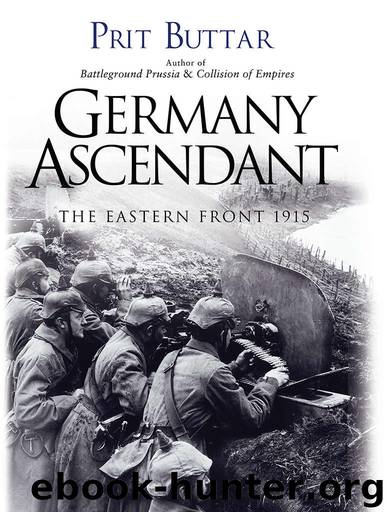Germany Ascendant: The Eastern Front 1915 (General Military) by Prit Buttar

Author:Prit Buttar [Buttar, Prit]
Language: eng
Format: epub
ISBN: 9781472815811
Publisher: Osprey Publishing
Published: 2015-08-25T00:00:00+00:00
Bukovina, May 1915
On 9 May, the Russian XXXIII Corps began to cross the River Dniester at Kopaczyńce, brushing aside the German 9th Cavalry Brigade. Reinforcements hastily dispatched to the area arrived too late, and General Wolf Marschall, the German commander of the mixed forces in the area, could do little more than attempt to seal off the Russian bridgehead. At the same time, Russian pressure to the west of Stanislau threatened the seam between Pflanzer-Baltin’s Seventh Army and the German South Army, preventing the withdrawal of troops from here with which the line further east might have been reinforced. Two days after they established their bridgehead, the Russians began to drive Marschall’s group back. Although Conrad had dispatched III Corps to Seventh Army, contrary to Falkenhayn’s wishes, these troops had no time to assemble and were fed into the growing crisis as they arrived; the railway line that they required was also the main supply route for Seventh Army, and its capacity was very limited. Matters were worsened for Pflanzer-Baltin by political interference. Prime Minister István Tisza of Hungary held back some Hungarian reservist drafts that were intended for Seventh Army, on the grounds that he needed to guard against possible hostile action from Romania.51
As the fighting continued to intensify, and casualties mounted – the first three days of the battle cost Marschall nearly half his men – Pflanzer-Baltin had no choice but to order a withdrawal back to the River Prut. There was heavy fighting near Kolomea where XXXIII Corps reduced one of the last Austro-Hungarian bridgeheads over the Prut on 13 May, but Pflanzer-Baltin remained determined to resume offensive operations as soon as possible. Linsingen’s South Army did actually make some headway against the Russians, advancing towards the town of Stryj despite terrain difficulties hindering the movement of artillery. The ground here was as difficult as elsewhere along the Carpathians:
We crossed the next mountain and entered a primeval forest which covered the whole side of the mountain. The ground was covered with the trunks of pine trees. The ones underneath were rotten, while those on top were hard and free of bark. At some places it was almost impossible to get through. In between the fallen trees were younger trees of all sizes, together with mature trees which were unbelievably tall and massive. The mountains here were very wild and rugged – no roads, bridges, or human habitation anywhere.52
Russian resistance now stiffened. On the left flank of South Army, Szurmay’s troops were effectively brought to a standstill. Repeated attacks towards Stryj also failed, and by 20 May, the Russians had halted Linsingen along his entire line.
Further east, the Russians continued their attacks on the Austro-Hungarian Seventh Army. Despite their best efforts at concealment, the Russians were unable to hide their preparations from their opponents, but when XXX Corps assaulted the left flank of Pflanzer-Baltin’s forces, it succeeded in taking Nadwórna on 15 May, and then attempted to redeploy forces to strike southeast across the Prut. Again, troops were ordered to move at night in order to try to avoid detection, and heavy fighting erupted on 19 May.
Download
This site does not store any files on its server. We only index and link to content provided by other sites. Please contact the content providers to delete copyright contents if any and email us, we'll remove relevant links or contents immediately.
| Africa | Americas |
| Arctic & Antarctica | Asia |
| Australia & Oceania | Europe |
| Middle East | Russia |
| United States | World |
| Ancient Civilizations | Military |
| Historical Study & Educational Resources |
Room 212 by Kate Stewart(4741)
The Crown by Robert Lacey(4577)
Endurance: Shackleton's Incredible Voyage by Alfred Lansing(4511)
The Iron Duke by The Iron Duke(4125)
The Rape of Nanking by Iris Chang(4024)
Killing England by Bill O'Reilly(3899)
Joan of Arc by Mary Gordon(3788)
Say Nothing by Patrick Radden Keefe(3730)
I'll Give You the Sun by Jandy Nelson(3274)
Shadow of Night by Deborah Harkness(3178)
Hitler's Monsters by Eric Kurlander(3166)
Mary, Queen of Scots, and the Murder of Lord Darnley by Alison Weir(3071)
Blood and Sand by Alex Von Tunzelmann(3060)
Darkest Hour by Anthony McCarten(3019)
Margaret Thatcher: The Autobiography by Thatcher Margaret(2972)
Eleanor & Park by Rainbow Rowell(2944)
Red Famine: Stalin's War on Ukraine by Anne Applebaum(2816)
Book of Life by Deborah Harkness(2723)
The One Memory of Flora Banks by Emily Barr(2687)
